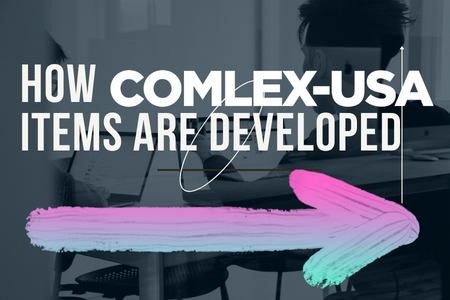Every test question that appears on a COMLEX-USA examination goes through a rigorous item writing and review process based on industry standards and best practices.
Item is the term we use to refer to a multiple-choice test question with a single best answer. Here is a summary of what makes our items distinct to osteopathic medicine as well as the main stages of item development (item writing, item review, pretesting, and periodic review).
OSTEOPATHIC DISTINCTIVENESS
COMLEX-USA is the only osteopathic medical licensure assessment series, and the evidence-based examinations created by the NBOME are unique in that they integrate the principles of osteopathic medicine—starting with the philosophy that every person is a unit of body, mind, and spirit. In other words, the COMLEX-USA examinations are distinct to the osteopathic profession and align with osteopathic medical education and comprehensive, evidence-based osteopathic medical patient care.
ITEM WRITING
The items on our examinations are written by members of our National Faculty, which numbers more than 700 active, engaged medical professionals with expertise across all osteopathic health professions and specialties. Item writers are assigned questions based on the COMLEX-USA blueprint, which integrates the osteopathic tenets throughout its competency domains and clinical presentations. Whole-patient care is reflected in the clinical scenarios, which often include structural examination findings and information on lifestyle and environmental factors that may impact patient wellbeing. To confirm the accuracy of item content, every item is prepared with a supporting reference from an up-to-date medical textbook, journal, or website.
ITEM REVIEW
Items are reviewed multiple times throughout their development by National Faculty committee members. Committees review test questions for accuracy, currency, fairness, and test-wise clues (i.e., are there hints within the item as to which answer options are correct or incorrect?).
NBOME editors review test questions to make sure that the test content is clear and the medical terminology adheres to the organization’s preferred usage and style. In addition, DOs are involved throughout the review process, whether the test question topic concerns basic sciences, communication, or patient care.
Evaluating test questions for bias is an important priority for the NBOME. Committee members evaluate test questions with the goal of ensuring person-centered language and a lack of biased content. The NBOME strives to ensure diversity of skin tones in photographs and videos throughout the exams. Diversity, equity, and inclusion were identified as key themes in the Special Commission on Osteopathic Medical Licensure Assessment Recommendations.
PRETESTING
Before a question is counted as part of candidates’ scores, it appears on examinations as a pretest item. A pretest item means that the item appears on an examination, but it is not used in the final calculation of the student’s score. Candidates do not know the difference between pretest and scorable questions, but the NBOME pays close attention to how candidates answer and comment on pretest items to determine whether they are appropriate to score in the future. So if you see an item that doesn’t make sense to you, you should comment about it to help us evaluate pretest items for future examinations.
PERIODIC REVIEW
After an item has been pretested, the review doesn’t stop. Test questions are routinely reviewed for accuracy, currency, and fairness. Candidate comments, examination statistics, and periodic review by National Faculty members ensure the validity of COMLEX-USA examinations. Items are removed from examinations if a review committee determines that the content is inaccurate, no longer reflects current medical practices, or exhibits bias in terminology.

